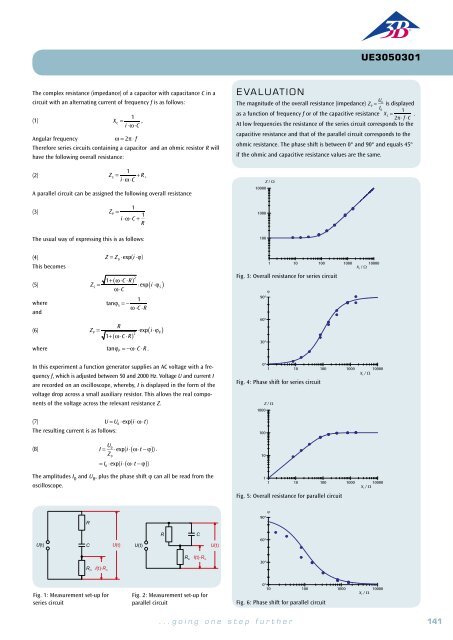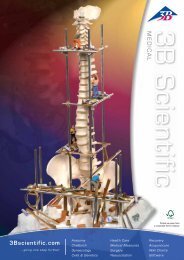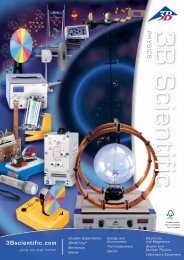3B Scientific - Physics & Engineering Experiments
3B Scientific - Physics & Engineering Experiments
3B Scientific - Physics & Engineering Experiments
You also want an ePaper? Increase the reach of your titles
YUMPU automatically turns print PDFs into web optimized ePapers that Google loves.
UE3050311<br />
Electricity / DC and AC<br />
AC Resistance<br />
UE3050311<br />
basic PRINCIPLES<br />
In AC circuits, it is common to use complex numbers to describe the<br />
resistance in circuits with inductors because this actually makes calculation<br />
easier. This is because not only the amplitude of the current and<br />
voltage is a factor, but also the phase relationships between the two<br />
need to be taken into account (this complex resistance is usually called<br />
impedance). Series and parallel circuits with both ohmic and inductive<br />
resistance can then be described quite easily, although in each case,<br />
only the real component is measurable).<br />
Z / Ù<br />
100000<br />
10000<br />
1000<br />
100<br />
EXPERIMENT<br />
PROCEDURE<br />
• Determine the amplitude and phase of<br />
the overall resistance as a function of<br />
frequency for a series circuit.<br />
• Determine the amplitude and phase of<br />
the overall resistance as a function of<br />
frequency for a parallel circuit.<br />
OBJECTIVE<br />
Determine the AC resistance in a circuit with inductive and resistive loads<br />
SUMMARY<br />
In AC circuits, not only ohmic resistance needs to be taken into account but also the resistance due to<br />
inductive loads. The combination of the two may be connected in series or parallel. This has an effect<br />
on both the amplitudes and phase of the current and voltage. In the experiment, this will be investigated<br />
using an oscilloscope and a function generator supplying alternating current with frequencies<br />
between 50 and 10000 Hz.<br />
Required Apparatus<br />
Quantity Description Number<br />
1 Plug-In Board for Components 1012902<br />
1 Resistor 1 Ω, 2 W, P2W19 1012903<br />
1 Resistor 100 Ω, 2 W, P2W19 1012910<br />
1 Function Generator FG 100 (230 V, 50/60 Hz) 1009957 or<br />
Function Generator FG 100 (115 V, 50/60 Hz) 1009956<br />
1 USB Oscilloscope 2x50 MHz 1017264<br />
1 HF Patch Cord, BNC/4 mm Plug 1002748<br />
1 Set of 15 Experiment Leads, 75 cm 1 mm² 1002840<br />
1 Coil S with 600 Taps 1001000<br />
2 Coil S with 1200 Taps 1001002<br />
The complex resistance (impedance) of a coil of inductance L in a circuit<br />
with an alternating current of frequency f is as follows:<br />
(1)<br />
X L<br />
= i ⋅2π⋅ f ⋅L<br />
Angular frequency<br />
ω = 2π⋅ f<br />
Therefore the total resistance (impedance) of a series circuit containing a<br />
coil with a resistance R is<br />
(2)<br />
Z S<br />
= i ⋅2π⋅ f ⋅L + R<br />
For a parallel circuit, the total resistance can be assigned thus:<br />
1<br />
Z<br />
(3)<br />
P<br />
=<br />
1<br />
i ⋅2π⋅ f ⋅L + 1 R<br />
The usual way of writing this is as follows:<br />
(4) Z = Z 0<br />
⋅exp(i ⋅ϕ) .<br />
This becomes<br />
(5)<br />
Z S<br />
=<br />
( 2π⋅ f ⋅L) 2 + R 2 ⋅exp( i ⋅ϕ S )<br />
2π⋅ f ⋅L<br />
where tanϕ S<br />
= )<br />
R<br />
and<br />
2π⋅ f ⋅L⋅R<br />
(6)<br />
Z P<br />
=<br />
2π⋅ f ⋅L<br />
R<br />
where<br />
tanϕ P<br />
=<br />
2π⋅ f ⋅L<br />
⋅exp( i ⋅ϕ<br />
( ) 2 P )<br />
+ R 2<br />
In this experiment a function generator supplies an AC voltage with an<br />
frequency f, which is adjusted between 50 and 10000 Hz. Voltage U and current<br />
I are recorded on an oscilloscope, whereby, I is displayed in the form of<br />
the voltage drop across a small auxiliary resistor. This allows the real components<br />
of the voltage across the relevant resistance Z to be measured.<br />
(7)<br />
U = U 0<br />
⋅exp(i ⋅2π⋅ f ⋅t)<br />
The resulting current is as follows:<br />
I = U 0<br />
⋅exp(i ⋅( 2π⋅ f ⋅t − ϕ))<br />
(8)<br />
Z 0<br />
= I 0<br />
⋅exp(i ⋅( 2π⋅ f ⋅t − ϕ))<br />
.<br />
The amplitudes I 0 and U 0 , plus the phase shift ϕ can all be read from the<br />
oscilloscope.<br />
10<br />
1 10 100 1000 10000<br />
X L / Ù<br />
Fig. 3: Overall resistance for series circuit<br />
ö<br />
90°<br />
60°<br />
30°<br />
10000<br />
0°<br />
1 10 100 1000 10000<br />
X L / Ù<br />
Fig. 4: Phase shift for series circuit<br />
1000<br />
100<br />
10<br />
Z / Ù<br />
1<br />
1 10 100 1000 10000<br />
X L / Ù<br />
Fig. 5: Overall resistance for parallel circuit<br />
ö<br />
90°<br />
2<br />
R<br />
U(t)<br />
L U(t)<br />
R m<br />
I(t)·R m<br />
Fig. 1: Measurement set-up for series circuit<br />
R<br />
L<br />
U(t)<br />
U(t)<br />
R m<br />
I(t)·R m<br />
Fig. 2: Measurement set-up for parallel circuit<br />
EVALUATION<br />
The magnitude of the overall resistance is Z 0<br />
= U 0<br />
displayed as a function<br />
of frequency f or of the inductive resistance<br />
I 0<br />
XL = 2π⋅ f ⋅L . If the<br />
inductive impedance is large, the resistance of the series circuit will<br />
have the value of the inductive resistance and the parallel circuit will<br />
have the value of the ohmic resistance. The phase shift is between 0°<br />
and 90° and equals 45° if the ohmic and inductive resistance values are<br />
the same.<br />
60°<br />
30°<br />
0°<br />
1 10 100 1000 10000<br />
X L / Ù<br />
Fig. 6: Phase shift for parallel circuit<br />
142 <strong>3B</strong> <strong>Scientific</strong>® <strong>Experiments</strong><br />
...going one step further<br />
143















